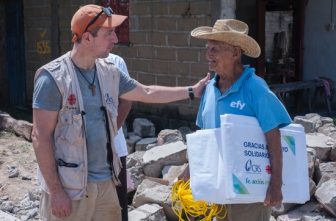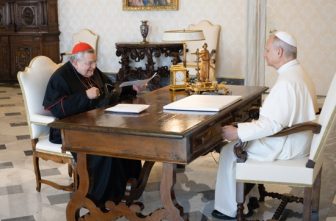
When Father John Ubel was 11 years old, his parish, Nativity of Our Lord in St. Paul, welcomed a refugee family displaced by the Vietnam War.
Father Ubel, rector of the Cathedral of St. Paul in St. Paul, recalled that experience Nov. 17 in the basement of the Cathedral to an audience that included many Hmong immigrants from St. Vincent de Paul in St. Paul, which is part of the Cathedral parish and serves Hmong Catholics. Some of them came to the U.S. from their native Laos in the 1970s after spending up to several years in refugee camps in Thailand.
“My mother began to tutor the (refugee) family in English,” Father Ubel said, “and it was an early introduction to what it means to be welcoming of people from all over the world who have found their way to Minnesota.”
To help people understand the history of local immigrant communities and their contribution to both the Church and the Cathedral, the Cathedral opened an exhibit called “Immigrants and the Cathedral: I was a stranger and you welcomed me.” The free exhibit in the Cathedral basement is open to the public every first and third Sunday from 11 a.m. to noon, Wednesdays from noon to 3 p.m., Thursdays from noon to 2:30 p.m. and Fridays from noon to 3 p.m. It is scheduled to run at least through spring 2020, though an end date has not been set.
Featured in the exhibit is a Hmong wedding dress worn by Mai Jhoua Yang, whose husband, Deacon Nao Kao Yang, serves at St. Vincent de Paul. The two married in 1978, and both are immigrants from Laos who spent time in refugee camps before coming to the U.S. Mai Jhoua bought the dress from a woman she met at a refugee camp, and her grandmother made the blouse and apron. She also wore a silver necklace passed down from her mother, Shoua Vang, who belongs to St. Vincent de Paul with her husband, Xiong Yang Vang.
“I feel honored and blessed to be able to show (the dress),” said Mai Jhoua, 59. “It’s very unique and special to be included in the history of the St. Paul Cathedral.”
Another item in the exhibit is a statue of Mary dressed in Hmong attire, which sits in the same display case as the wedding dress. Father Ubel said “the Hmong clothing items are amazing in their intricacies. The amount of detail is beyond description.” Visitors also can watch a short video about the history and struggles of Hmong people who came to Minnesota and joined St. Vincent de Paul parish.
The exhibit also highlights the Shrine of Nations, a portion of the Cathedral located behind the sanctuary that recognizes six ethnic groups of the 1850s. A 1907 blueprint on display shows the six scallops slated to become the Shrine of Nations. The exhibit features large images of the statuary and stained glass from the Shrine of Nations, which are accompanied by explanations of the saints’ connections to each country and descriptions of the imagery in the stained glass.
“I hope that visiting school groups, in particular, will take 15 extra minutes to come downstairs to learn more about the immigrants whose sacrifices made this Cathedral possible,” Father Ubel said. “The exhibit has some great stories about the design of the shrines and their history. It is fascinating.”
He added: “We mustn’t forget our roots. The words of the late St. Paul philanthropist John Nasseff come to mind: ‘Never forget where you came from.’”



